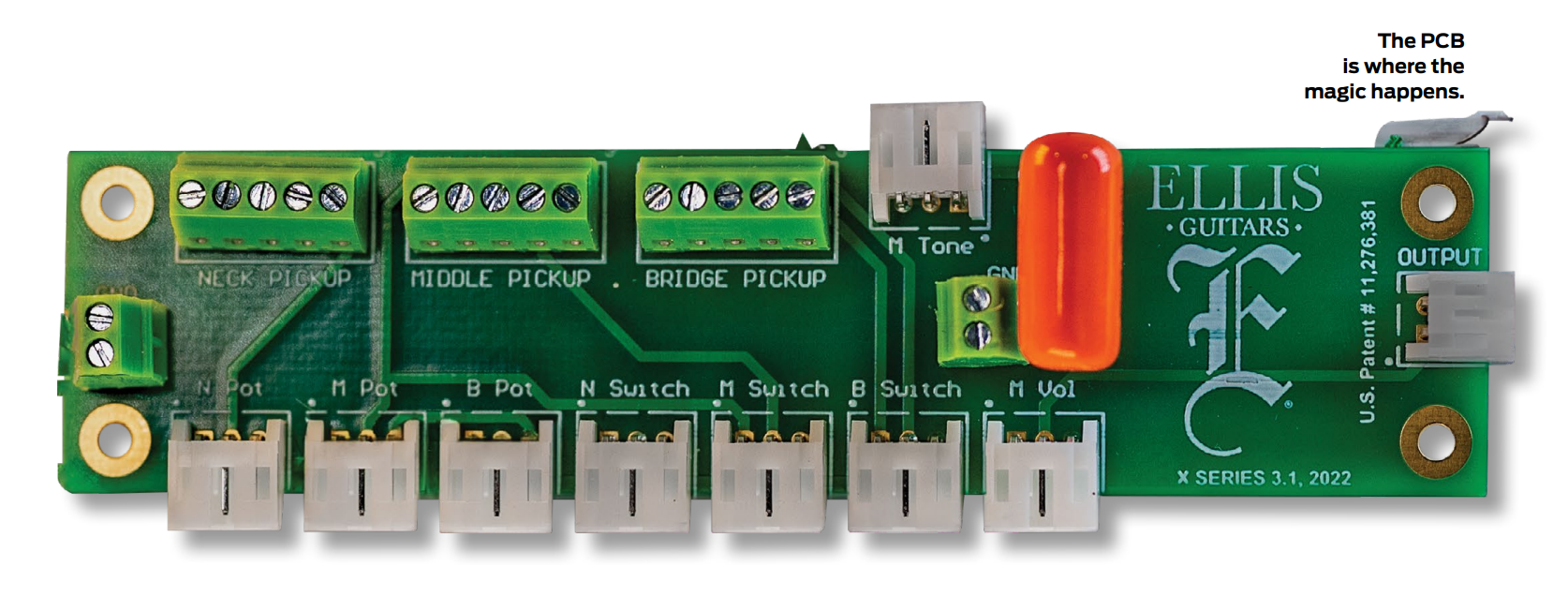GuitarPlayer Verdict
The X Series can add a lot of flexibility to any guitar, and the clever design and pre-fab wiring package minimizes the effort required to install it
Pros
- +
Unlocks a myriad of sounds from an otherwise standard guitar with one, two or three pickups: humbuckers, single-coils and P90s are all supported
Cons
- -
None
You can trust Guitar Player.
Based in Houston, Texas, Ellis Guitars offers a series of guitars and basses as well as this novel passive electronics system that is designed to deliver sounds similar to popular Fender and Gibson guitars from any instrument equipped with one, two or three standard humbuckers, as well as single-coils and P-90s. The idea behind it is that, instead of hauling multiple guitars to a session or live gig, you can bring just one instrument and have those distinct tones at your fingertips.
The X Series is offered as a kit for DIY retrofitting to a guitar or bass of your choice, the only requirement being each pickup needs to have no less than two and no more than five, output wires. An installation video demonstrates the system being installed in a Les Paul-style guitar and the procedure is relatively straightforward. The original hardware (potentiometers, toggle switches and output jack) are removed, requiring a few leads to be cut or unsoldered, so all that’s left inside the control cavity are the wires from the pickups and the bridge-ground wire. Strips of copper-foil tape (included) are used to connect the holes where the original pots went.
The install requires two holes drilled for the system’s mini-toggle switches (one for each humbucker), and it may also be necessary to enlarge the holes for the four pots that are included with the system (details are provided in the instructions).
The new components are designed to drop right in, and from there you just need to connect the hardware to the printed circuit board (PCB) with the snap connectors, attach the pickup wires to the solderless screw connectors in the correct order (the pickup manufacturer’s wiring code needs to be referenced here), and then connect the bridge and potentiometer ground wires to the solderless screw terminal. Tuck the wires in place, put the cover plate back on and start enjoying the sounds the system unlocks.
We were spared the trouble of finding a suitable donor guitar for this review because Ellis sent one of their TX2 models ($2,700 as tested) fitted with two Custom Humbuckers – a Mighty Rigel in the neck position and a Johnny B at the bridge – and the X Series system pre-installed. The controls consist of master volume and tone, two smaller knobs for the individual pickup volumes and two mini-toggle switches for selecting coils on each pickup.
With the guitar plugged into a Fender Deluxe Reverb and a new Tonemaster Princeton Reverb, I started out using Ellis’s suggested settings to get Telecaster-, Les Paul- and Stratocaster-style bridge pickup tones, which was just a matter of turning the bridge pickup volume to 100 percent, neck volume off, and setting the rearmost toggle switch to, respectively, the rear, middle or forward positions.

With the actual guitars on hand for comparison, these approximations of the bridge-pickup tones and corresponding output levels were on target, although to my ears the TX2 sounded a little thicker than the single-coil Fenders, and my Historic ’59 Les Paul had more snarl in its voice than the TX2. Nevertheless it’s pretty good considering that the TX2 is such a different animal construction-wise, as it features a body with an oak top and back, a Honduran mahogany center, and a bolt-on mahogany neck with a flame-maple fretboard.
All the latest guitar news, interviews, lessons, reviews, deals and more, direct to your inbox!
Sampling neck-pickup tones for the same guitars – and using the recommended settings of neck volume at 100 percent, bridge volume off and the forward-most toggle switch in the bridge, middle and forward positions, respectively – yielded similar results, with the Tele setting sounding characteristically warm and somewhat anemic on the output side; the Les Paul more muscular, bright and open; and the Strat setting yielding a tone that sounded great clean and went naturally into the blues zone when given some grind from a TWA SH9 pedal.
Turning both volume controls all the way up resulted in tones that sounded in the ballpark of the reference guitars in their dual-pickup positions, and while I wasn’t able to get the chimey tones of the Strat’s neck/middle and middle/bridge combinations, there are a lot of nice sounds on tap here that are available by using different combinations of settings. The suggested “custom” configurations included turning both knobs full up and setting the switches to their inner and outer positions – two alternate and very satisfying rhythm tones – or putting both switches in the middle, which delivered a cool mids-forward tone that sounded great with distortion.
The X Series can add a lot of flexibility to any guitar
Alternately, setting the front pickup switch to the middle position, the rear pickup switch to the bridge position and rolling the neck volume down a bit yielded a meaty lead tone that sounded badass and cleaned up well by backing off on the picking strength or simply turning down the TX2’s master volume. All these sounds can be dialed-in to taste by blending the pickup volumes in different ratios, which is a very effective way of shaping tones on the fly. It’s also very accommodating whatever your playing style or preference for cleaner or more heavily overdriven tones.
Bottom line, the X Series can add a lot of flexibility to any guitar, and the clever design and pre-fab wiring package minimizes the effort required to install it. All said, if you’re seeking to enhance the tonal capabilities of a guitar or bass, this system is definitely worth considering.
Specifications
- CONTROLS: Individual pickup volume controls and 3-way mini-toggle switches for pickup-coil selection
- EXTRAS: PCB with push-in connectors for the pickups, controls and output jack. System works with any electric guitar or bass equipped with passive pickups regardless of type
Visit Ellis Guitars for more information.

Art Thompson is Senior Editor of Guitar Player magazine. He has authored stories with numerous guitar greats including B.B. King, Prince and Scotty Moore and interviewed gear innovators such as Paul Reed Smith, Randall Smith and Gary Kramer. He also wrote the first book on vintage effects pedals, Stompbox. Art's busy performance schedule with three stylistically diverse groups provides ample opportunity to test-drive new guitars, amps and effects, many of which are featured in the pages of GP.

